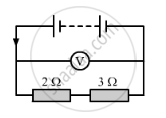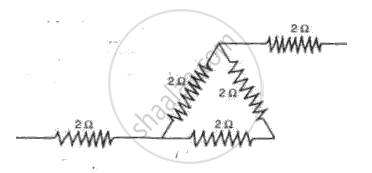Advertisements
Advertisements
प्रश्न
60 joules of heat was dissipated in a resistor when 20 C flowed for 5 s. Calculate:
(a) P.d. across the resistor,
(b) Resistance of the resistor, and
(c) Average power dissipated in the resistor.
उत्तर
Given, heat dissipated= 60 joules, charge Q = 20 C, time t= 5s
(a) P.d. across the rsistor, V = `"W"/"Q"= 60/20 = 3 "V"`
(b) Power = `"W"/"t" = "V"^2/"R"`
R = `"V"^2 xx "t"/"W" = (3)^2 xx 5/60 = 0.75 Omega`
(c) Power dissipated, P = `"W"/"t" = 60/5 = 12 "watt"`
APPEARS IN
संबंधित प्रश्न
Why are metals good conductors of electricity whereas glass is a bad conductor of electricity? Give reason?
In the circuit shown below, the voltmeter reads 10 V.

(a) What is the combined resistance?
(b) What current flows?
(c) What is the p.d. across 2 Ω resistor?
(d) What is the p.d. across 3 Ω resistor?
Define the following:
Super conductors.
Find the effective resistance in the following circuit diagrams (Fig.):

The following appliances are to be used on 240 V supply. Calculate the current used by each and say which fuse, 2 amp, 5 amp or 13 amp should be incorporated with each, (i) A television rated at 150 W, (ii) An electric iron rated at 750 W, (iii) An immersion heater rated at 3000 W, (iv) A hair dryer rated at 500 W. How much will it cost to run the television set for 100 days for an average of 4 hours a day at 60 paise per unit?
Answer the following question.
An electric lamp of resistance 20 Ω and a conductor of resistance 4 0 are connected to a 6 V battery as shown in the circuit. Calculate: 
(a) the total resistance of the circuit,
(b) the current through the circuit,
(c) the potential difference across the (i) electric lamp and (ii) conductor, and
(d) power of the lamp.
______ is used to measure the electric current.
For current to flow, one needs art open circuit.
